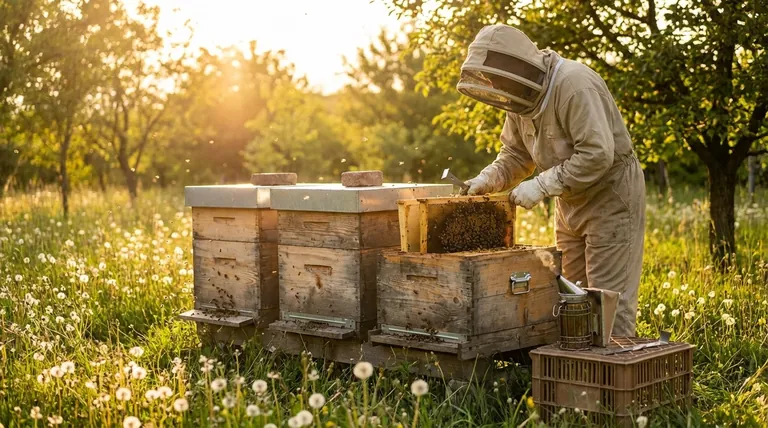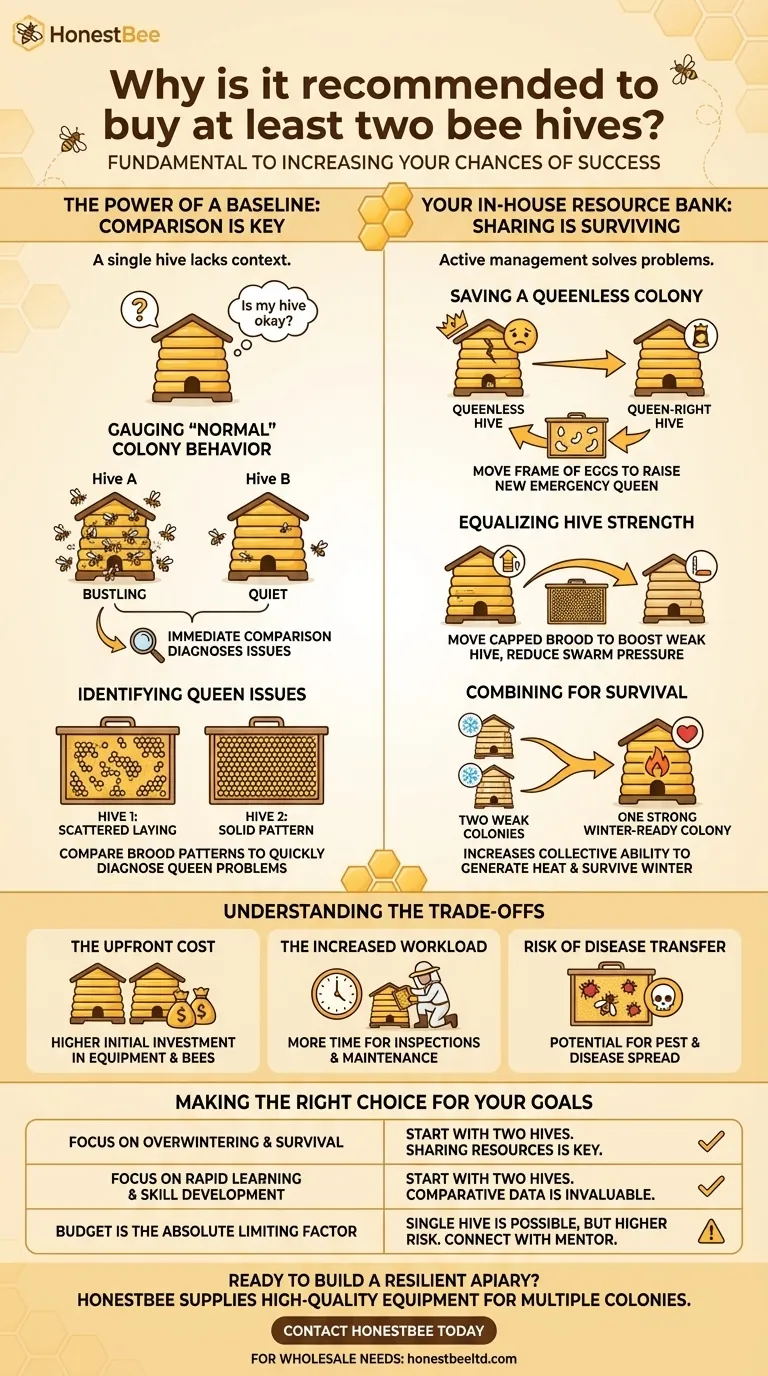Starting with at least two beehives is one of the most common and crucial pieces of advice for new beekeepers. This recommendation is not about doubling your honey harvest from day one, but about fundamentally increasing your chances of success. By running two colonies side-by-side, you gain the invaluable ability to compare their health and share resources between them, turning potential disasters into manageable learning experiences.
While it seems counterintuitive, managing two hives is often easier and significantly less risky than managing one. A second hive acts as an insurance policy and a resource bank, dramatically increasing the odds that your colonies will thrive.

The Power of a Baseline: Comparison is Key
A single beehive exists in a vacuum. As a new beekeeper, you have no reference point to judge its activity. Is the population size normal? Is their temperament typical? A second hive provides an immediate, real-time baseline for comparison.
Gauging "Normal" Colony Behavior
Every new beekeeper asks, "Is my hive okay?" With one hive, this question is nearly impossible to answer. With two, you can simply look.
If Hive A is bustling with activity and Hive B is quiet, you have an immediate reason to investigate Hive B more closely. This comparison helps you learn what a healthy, productive colony looks like in your specific environment and season.
Identifying Queen Issues
A colony's health is directly tied to its queen. If a queen fails, the colony is doomed unless the beekeeper intervenes.
With two hives, you can compare brood patterns. If one queen is laying eggs in a scattered, inconsistent pattern while the other is laying in a dense, solid frame, you can quickly diagnose a potential queen problem in the first hive.
Your In-House Resource Bank: Sharing is Surviving
The true power of a second hive lies in the ability to share resources. This turns you from a passive observer into an active manager who can solve problems that would otherwise destroy a single colony.
Saving a Queenless Colony
If one hive loses its queen, it cannot produce new bees and will eventually collapse. This is a common point of failure.
However, if you have a healthy, queen-right hive nearby, you can take a frame containing fresh eggs and young larvae and give it to the queenless hive. The workers in the queenless colony can use these borrowed eggs to raise a new emergency queen, saving the entire colony.
Equalizing Hive Strength
It is common for one hive to be stronger than another. A very strong hive might be prone to swarming, while a weak hive may struggle to gather enough resources or defend itself.
You can "equalize" the hives by moving a frame of capped brood (bees about to hatch) from the strong hive to the weak one. This boosts the weak hive's population and slightly reduces swarm pressure in the strong one, creating two robust, manageable colonies.
Combining for Survival
Sometimes, despite your best efforts, one or both colonies may be too weak to survive the winter on their own.
Rather than losing both, you can combine them into a single, strong colony. This dramatically increases their collective ability to generate heat and consume resources efficiently, giving them a much better chance of surviving until spring.
Understanding the Trade-offs
While the two-hive approach is highly recommended, it's essential to acknowledge the drawbacks.
The Upfront Cost
The most significant barrier is the initial investment. You will need to purchase two sets of hive components (boxes, frames, bottom boards, lids), two packages of bees, and have enough protective gear.
The Increased Workload
Managing two hives requires more time for inspections and maintenance than managing one. However, this also doubles your learning opportunities and accelerates your development as a beekeeper.
Risk of Disease Transfer
When you move frames between hives, you run the risk of transferring pests or diseases, like Varroa mites or foulbrood. This underscores the importance of vigilant monitoring and good apiary hygiene from the very beginning.
Making the Right Choice for Your Beekeeping Goals
Ultimately, the decision rests on your goals and resources. Consider your primary motivation for starting this journey.
- If your primary focus is successful overwintering and long-term colony survival: Start with two hives. The ability to share resources is the single greatest advantage you can have.
- If your primary focus is rapid learning and skill development: Start with two hives. The comparative data you gain from observing two colonies is invaluable and will make you a better beekeeper, faster.
- If your budget is the absolute limiting factor: A single hive is still a valid starting point, but you must acknowledge the higher risk and be prepared. Connect with a local beekeeping club or mentor who might be able to provide an emergency frame of eggs if your hive becomes queenless.
Investing in a second hive from the start is an investment in your own success and the resilient health of your bees.
Summary Table:
| Advantage | How It Helps Beekeepers |
|---|---|
| Provides a Baseline | Compare hive health, activity, and queen performance to spot issues early. |
| Acts as a Resource Bank | Share frames of eggs or brood to save a queenless hive or equalize colony strength. |
| Increases Survival Odds | Combine weak colonies for winter or manage swarming behavior more effectively. |
Ready to build a resilient apiary?
Starting with two hives is the smartest investment for long-term success. HONESTBEE supplies commercial apiaries and beekeeping equipment distributors with the high-quality, durable supplies needed to manage multiple colonies effectively.
Contact HONESTBEE today to discuss your wholesale needs and ensure your beekeeping operation is built on a foundation of success.
Visual Guide

Related Products
- HONESTBEE Advanced Ergonomic Stainless Steel Hive Tool for Beekeeping
- Professional Dual-End Stainless Steel Hive Tool for Beekeeping
- HONESTBEE Professional Long Handled Hive Tool with Precision Cutting Blade
- Langstroth Bee Hives Bee Keeping Box for Beginners Beekeeping
- Wholesales Dadant Size Wooden Bee Hives for Beekeeping
People Also Ask
- What is a hive tool and what are its uses? Master Your Hive Inspections with the Essential Beekeeper's Tool
- How is a hive tool used for scraping and cleaning? Master Hive Maintenance for a Healthy Colony
- How should beekeepers handle bees when using a hive tool? Master Calm, Deliberate Techniques
- What are the features of a regular hive tool? The Essential Multi-Tool for Every Beekeeper
- What is the hole in a hive tool for? A Multi-Tool for Apiary Repairs and Maintenance



















